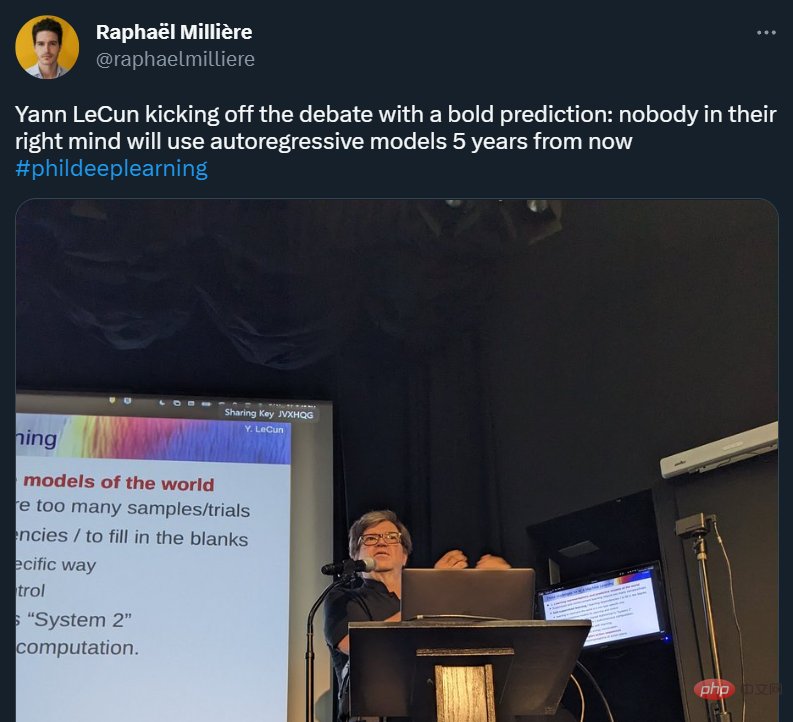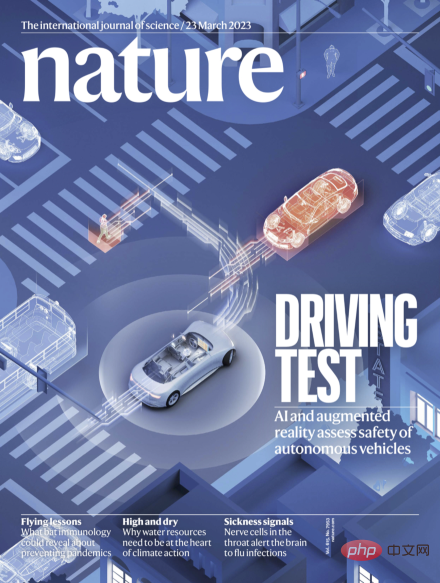 Technology peripherals
Technology peripherals AI
AI Nature sub-journal: New algorithm can predict crime within two blocks a week in advance, with an accuracy of 90% in 8 US cities
Nature sub-journal: New algorithm can predict crime within two blocks a week in advance, with an accuracy of 90% in 8 US citiesIshanu Chattopadhyay, an assistant professor at the University of Chicago, told Insider that he and his team created an "urban twin" model by analyzing Chicago's crime data from 2014 to the end of 2016. Training, can predict the likelihood of certain crimes in the coming weeks and narrow it down to a two-block radius with 90% accuracy.
Chattopadhyay said, "We report a method for predicting urban crime at the individual incident level with far higher predictive accuracy. in the past. "
"We demonstrated that discovering city-specific crime patterns is useful for predicting crime reports," James Evans, co-author of the paper, told Science Daily importance, which generates a new view of urban communities, allows us to ask novel questions, and allows us to evaluate police operations in new ways."
The research was published in Nature Human Behavior.

##Paper link:
https://www.nature.com/articles/s41562-022-01372-0
Predicting future crimes
The data for the model comes from historical data for the city of Chicago, which includes two broad categories of reported incidents: violent crime (murder, assault, and battery) and property crime (burglary, theft, and motor vehicle theft).
Chicago’s crime rate in 2020 was 67% higher than the national average, according to data compiled by AreaVibes.
This data is used because it is most likely to be reported to police in urban areas where there has been a history of distrust and lack of contact with police. Cooperation with law enforcement.
#Unlike drug crimes, traffic stops and other minor offenses, these crimes are also less prone to law enforcement bias.
# By testing and validating the data, the new model trained can accurately predict the pattern of events in the coming weeks by observing the time and spatial coordinates of discrete events. , the geographical scope can be controlled to about two blocks.

##The model is available in seven other cities (Atlanta, Austin, Detroit, Los Angeles, Philadelphia, Portland and San Francisco .) also obtained similar results, focusing primarily on the type of crime and where it occurred.
"We create a digital twin of an urban environment. If you feed it data from what happened in the past, it tells you what will happen in the future, "It's not magic, there are some limitations, but we verified it and it worked really well," Chattopadhyay said.
Potential biasLead author Ishanu Chattopadhyay is careful to note that “the tool’s accuracy does not mean it should be used to guide law enforcement policy—for example, police departments should not use it to proactively gather Some community to prevent crime,” Chattopadhyay said.
# Instead, it should be added to the toolbox of urban policy and policing strategies to address crime. "Now, you can use it as a simulation tool to see what would happen if crime increased in one area of the city, or if law enforcement increased in another area. What if You apply all these different variables and you can see how the system responds to them," explains Chattopadhyay. The research team also studied police responses to crime by analyzing the number of arrests made after an incident and comparing arrest rates in different communities. Racial bias in policing imposes high economic costs and exacerbates inequality in areas already suffering from severe deprivation, according to research compiled by Econofact . They found that when crime rates rise in wealthy areas, more people are arrested. But this is not happening in disadvantaged communities, which shows that police response and enforcement are uneven. Therefore, Chattopadhyay made these data and algorithms public to strengthen review, he hopes the findings will be used for high-level policy rather than as a police response tool. #Despite this, there are still many doubts about such research. #In 2016, the Chicago Police Department experimented with a model to predict those most likely to be involved in shootings, but the mysterious list ultimately revealed, Fifty-six percent of black men living in Chicago were on the list, sparking accusations of racism. While some models attempt to eradicate these biases, they often have the opposite effect, with some accusing racial bias in the underlying data of fueling future prejudicial behavior. Lawrence Sherman of the Cambridge Center for Evidence-Based Policing told New Scientist he was concerned the study would include policing data that relied on citizen reporting or The police are out in search of criminal behavior. Chattopadhyay agrees that this is a problem, and his team attempts to do so by excluding citizen-reported crimes and police intervention, which often involve minor drug offenses and traffic stops. and more serious violent and property crimes (which are more likely to be reported in any case) to explain this. Chattopadhyay said: “Ideally, if you can predict or prevent crime, the only response shouldn’t be to send more police or have law enforcement in large numbers. flock to a particular community." "If you can prevent crime, there are a lot of other things we can do to prevent this type of thing from happening so Someone will go to jail and help society as a whole." 
The above is the detailed content of Nature sub-journal: New algorithm can predict crime within two blocks a week in advance, with an accuracy of 90% in 8 US cities. For more information, please follow other related articles on the PHP Chinese website!
 ai合并图层的快捷键是什么Jan 07, 2021 am 10:59 AM
ai合并图层的快捷键是什么Jan 07, 2021 am 10:59 AMai合并图层的快捷键是“Ctrl+Shift+E”,它的作用是把目前所有处在显示状态的图层合并,在隐藏状态的图层则不作变动。也可以选中要合并的图层,在菜单栏中依次点击“窗口”-“路径查找器”,点击“合并”按钮。
 ai橡皮擦擦不掉东西怎么办Jan 13, 2021 am 10:23 AM
ai橡皮擦擦不掉东西怎么办Jan 13, 2021 am 10:23 AMai橡皮擦擦不掉东西是因为AI是矢量图软件,用橡皮擦不能擦位图的,其解决办法就是用蒙板工具以及钢笔勾好路径再建立蒙板即可实现擦掉东西。
 谷歌超强AI超算碾压英伟达A100!TPU v4性能提升10倍,细节首次公开Apr 07, 2023 pm 02:54 PM
谷歌超强AI超算碾压英伟达A100!TPU v4性能提升10倍,细节首次公开Apr 07, 2023 pm 02:54 PM虽然谷歌早在2020年,就在自家的数据中心上部署了当时最强的AI芯片——TPU v4。但直到今年的4月4日,谷歌才首次公布了这台AI超算的技术细节。论文地址:https://arxiv.org/abs/2304.01433相比于TPU v3,TPU v4的性能要高出2.1倍,而在整合4096个芯片之后,超算的性能更是提升了10倍。另外,谷歌还声称,自家芯片要比英伟达A100更快、更节能。与A100对打,速度快1.7倍论文中,谷歌表示,对于规模相当的系统,TPU v4可以提供比英伟达A100强1.
 ai可以转成psd格式吗Feb 22, 2023 pm 05:56 PM
ai可以转成psd格式吗Feb 22, 2023 pm 05:56 PMai可以转成psd格式。转换方法:1、打开Adobe Illustrator软件,依次点击顶部菜单栏的“文件”-“打开”,选择所需的ai文件;2、点击右侧功能面板中的“图层”,点击三杠图标,在弹出的选项中选择“释放到图层(顺序)”;3、依次点击顶部菜单栏的“文件”-“导出”-“导出为”;4、在弹出的“导出”对话框中,将“保存类型”设置为“PSD格式”,点击“导出”即可;
 ai顶部属性栏不见了怎么办Feb 22, 2023 pm 05:27 PM
ai顶部属性栏不见了怎么办Feb 22, 2023 pm 05:27 PMai顶部属性栏不见了的解决办法:1、开启Ai新建画布,进入绘图页面;2、在Ai顶部菜单栏中点击“窗口”;3、在系统弹出的窗口菜单页面中点击“控制”,然后开启“控制”窗口即可显示出属性栏。
 GPT-4的研究路径没有前途?Yann LeCun给自回归判了死刑Apr 04, 2023 am 11:55 AM
GPT-4的研究路径没有前途?Yann LeCun给自回归判了死刑Apr 04, 2023 am 11:55 AMYann LeCun 这个观点的确有些大胆。 「从现在起 5 年内,没有哪个头脑正常的人会使用自回归模型。」最近,图灵奖得主 Yann LeCun 给一场辩论做了个特别的开场。而他口中的自回归,正是当前爆红的 GPT 家族模型所依赖的学习范式。当然,被 Yann LeCun 指出问题的不只是自回归模型。在他看来,当前整个的机器学习领域都面临巨大挑战。这场辩论的主题为「Do large language models need sensory grounding for meaning and u
 强化学习再登Nature封面,自动驾驶安全验证新范式大幅减少测试里程Mar 31, 2023 pm 10:38 PM
强化学习再登Nature封面,自动驾驶安全验证新范式大幅减少测试里程Mar 31, 2023 pm 10:38 PM引入密集强化学习,用 AI 验证 AI。 自动驾驶汽车 (AV) 技术的快速发展,使得我们正处于交通革命的风口浪尖,其规模是自一个世纪前汽车问世以来从未见过的。自动驾驶技术具有显着提高交通安全性、机动性和可持续性的潜力,因此引起了工业界、政府机构、专业组织和学术机构的共同关注。过去 20 年里,自动驾驶汽车的发展取得了长足的进步,尤其是随着深度学习的出现更是如此。到 2015 年,开始有公司宣布他们将在 2020 之前量产 AV。不过到目前为止,并且没有 level 4 级别的 AV 可以在市场
 ai移动不了东西了怎么办Mar 07, 2023 am 10:03 AM
ai移动不了东西了怎么办Mar 07, 2023 am 10:03 AMai移动不了东西的解决办法:1、打开ai软件,打开空白文档;2、选择矩形工具,在文档中绘制矩形;3、点击选择工具,移动文档中的矩形;4、点击图层按钮,弹出图层面板对话框,解锁图层;5、点击选择工具,移动矩形即可。


Hot AI Tools

Undresser.AI Undress
AI-powered app for creating realistic nude photos

AI Clothes Remover
Online AI tool for removing clothes from photos.

Undress AI Tool
Undress images for free

Clothoff.io
AI clothes remover

AI Hentai Generator
Generate AI Hentai for free.

Hot Article

Hot Tools

EditPlus Chinese cracked version
Small size, syntax highlighting, does not support code prompt function

ZendStudio 13.5.1 Mac
Powerful PHP integrated development environment

Safe Exam Browser
Safe Exam Browser is a secure browser environment for taking online exams securely. This software turns any computer into a secure workstation. It controls access to any utility and prevents students from using unauthorized resources.

Dreamweaver Mac version
Visual web development tools

VSCode Windows 64-bit Download
A free and powerful IDE editor launched by Microsoft





